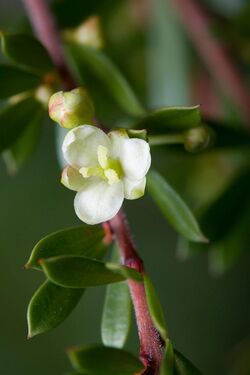Biology:Micrantheum serpentinum
| Micrantheum serpentinum | |
|---|---|

| |
| In the Royal Tasmanian Botanical Gardens | |
| Scientific classification | |
| Kingdom: | Plantae |
| Clade: | Tracheophytes |
| Clade: | Angiosperms |
| Clade: | Eudicots |
| Clade: | Rosids |
| Order: | Malpighiales |
| Family: | Picrodendraceae |
| Genus: | Micrantheum |
| Species: | M. serpentinum
|
| Binomial name | |
| Micrantheum serpentinum Orchard[1]
| |
Micrantheum serpentinum, commonly known as western tridentbush,[2] is a species of flowering plant in the family Picrodendraceae, and is endemic to north-western Tasmania.[2] It is a straggly, monoecious shrub with oblong to narrowly egg-shaped leaves and yellowish to greenish flowers.
Description
Micrantheum serpentinium is a straggly, monoecious shrub with many branches and that typically grows to a height of up to 2 m (6 ft 7 in). Its leaves are arranged in groups of three and are oblong to narrowly egg-shaped, 5–9 mm (0.20–0.35 in) long and 1.5–3.3 mm (0.059–0.130 in) wide. The leaves are leathery, more or less glabrous, dark glossy green on the upper surface and paler below. The flowers are arranged singly in upper leaf axils, the male flowers bove the female flowers. The tepals are less than 2.5 mm (0.098 in) long and yellowish to greenish with a red tinge. Male flowers have six stamens and female flowers three styles. Flowering occurs from September to early November and the fruit is a yellowish-black, oval capsule 3.0–3.3 mm (0.12–0.13 in) long with the remains of the styles attached.[2]
Taxonomy
Micrantheum serpentinium was first formally described in 1991 by Anthony Edward Orchard in Aspects of Tasmanian Botany - a tribute to Winifred Curtis.[3]
Distribution and habitat
Western tridentbush grows in shrubby, low, open woodland, shrubland or heath, usually on rocky hills sides in serpentinite geology, and is endemic to the Cradle Coast of north-western Tasmania.[2][4]
Conservation status
This species of Micrantheum is listed as "rare" under the Tasmanian Government Threatened Species Protection Act 1995. The threats to the species include inappropriate fire regimes, land clearing, infestation by Phytophthora cinnamomi, and weed invasion.[2]
References
- ↑ "Micrantheum serpentinum". Australian Plant Census. https://biodiversity.org.au/nsl/services/apc-format/display/119311.
- ↑ 2.0 2.1 2.2 2.3 2.4 "Threatened species link - Micrantheum serpentinum". Tasmanian Government Department of Natural Resources and Environment, Tasmania. https://www.naturalvaluesatlas.tas.gov.au/downloadattachment?id=14202.
- ↑ "Micrantheum serpentinum". APNI. https://id.biodiversity.org.au/instance/apni/553501. Retrieved 18 September 2023.
- ↑ Jordan, Greg. "Micrantheum serpentinum". University of Tasmania. https://www.utas.edu.au/dicotkey/dicotkey/EUPHORBS/sMicrantheum_serpentinum.htm.
Wikidata ☰ Q3022279 entry
 |

